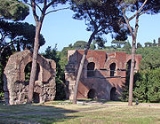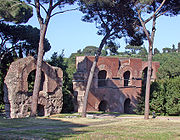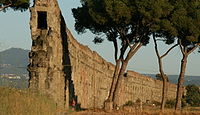
Aqua Claudia
Encyclopedia


Roman aqueduct
The Romans constructed numerous aqueducts to serve any large city in their empire, as well as many small towns and industrial sites. The city of Rome had the largest concentration of aqueducts, with water being supplied by eleven aqueducts constructed over a period of about 500 years...
that, like the Anio Novus
Anio Novus
Anio Novus is an aqueduct of Rome. Together with the Aqua Claudia, it was begun by emperor Caligula in 38 AD and completed in 52 AD by Claudius, who dedicated them both on August 1.-Details:...
, was begun by emperor Caligula
Caligula
Caligula , also known as Gaius, was Roman Emperor from 37 AD to 41 AD. Caligula was a member of the house of rulers conventionally known as the Julio-Claudian dynasty. Caligula's father Germanicus, the nephew and adopted son of Emperor Tiberius, was a very successful general and one of Rome's most...
in 38 AD and completed by Emperor Claudius in 52 AD. Its main springs, the Caeruleus and Curtius, were situated 300 paces to the left of the thirty-eighth milestone of the Via Sublacensis
Via Sublacensis
The Via Sublacensis was a Roman road constructed to connect Nero's palace in present-day Subiaco to Rome, splitting off from the Via Valeria near Varia , about 10 km northeast of Tivoli....
. After being in use for ten years, the supply failed, and was interrupted for nine years, until Emperor Vespasian restored it in 71
71
Year 71 was a common year starting on Tuesday of the Julian calendar. At the time, it was known as the Year of the Consulship of Augustus and Nerva...
, and ten years later Titus
Titus
Titus , was Roman Emperor from 79 to 81. A member of the Flavian dynasty, Titus succeeded his father Vespasian upon his death, thus becoming the first Roman Emperor to come to the throne after his own father....
once more.
Structure
The channel length was 45–46 miles (ca. 69 km, most of which was underground), and volume at the springs was 191,190 cubic metres in 24 hours. Following NeroNero
Nero , was Roman Emperor from 54 to 68, and the last in the Julio-Claudian dynasty. Nero was adopted by his great-uncle Claudius to become his heir and successor, and succeeded to the throne in 54 following Claudius' death....
's completion of the Arcus Neroniani, one of the aqueduct's branches, the Aqua Claudia could provide all 14 Roman districts with water. Directly after its filtering tank, near the seventh mile of the Via Latina
Via Latina
The Via Latina was a Roman road of Italy, running southeast from Rome for about 200 kilometers.It led from the Porta Latina in the Aurelian walls of Rome to the pass of Mons Algidus; it was important in the early military history of Rome...
, it finally emerged onto arches, which increase in height as the ground falls towards the city. It is also one of the two ancient aqueducts that flowed through the Porta Maggiore
Porta Maggiore
The Porta Maggiore , or Porta Prenestina, is one of the eastern gates in the ancient but well-preserved 3rd-century Aurelian Walls of Rome....
, the other being the Anio Novus. It is described in some detail by Frontinus in his work published in the later first century, De aquaeductu.
The church of San Tommaso in Formis
San Tommaso in Formis
The church of San Tommaso in Formis is a small church in Rome, situated on the Caelian Hill.-History:Situated on the edge of Villa Celimontana and next to the Arch of Dolabella , a gate in the original Servian Wall, the church is dedicated to St. Thomas the Apostle...
was later built into the side of the acqueduct.
See also
- Ancient Roman technology
- Frontinus
- List of aqueducts in the city of Rome
- List of aqueducts in the Roman Empire
- List of Roman aqueducts by date
- Roman engineeringRoman engineeringRomans are famous for their advanced engineering accomplishments, although some of their own inventions were improvements on older ideas, concepts and inventions. Technology for bringing running water into cities was developed in the east, but transformed by the Romans into a technology...
- Roman technologyRoman technologyRoman technology is the engineering practice which supported Roman civilization and made the expansion of Roman commerce and Roman military possible over nearly a thousand years....

